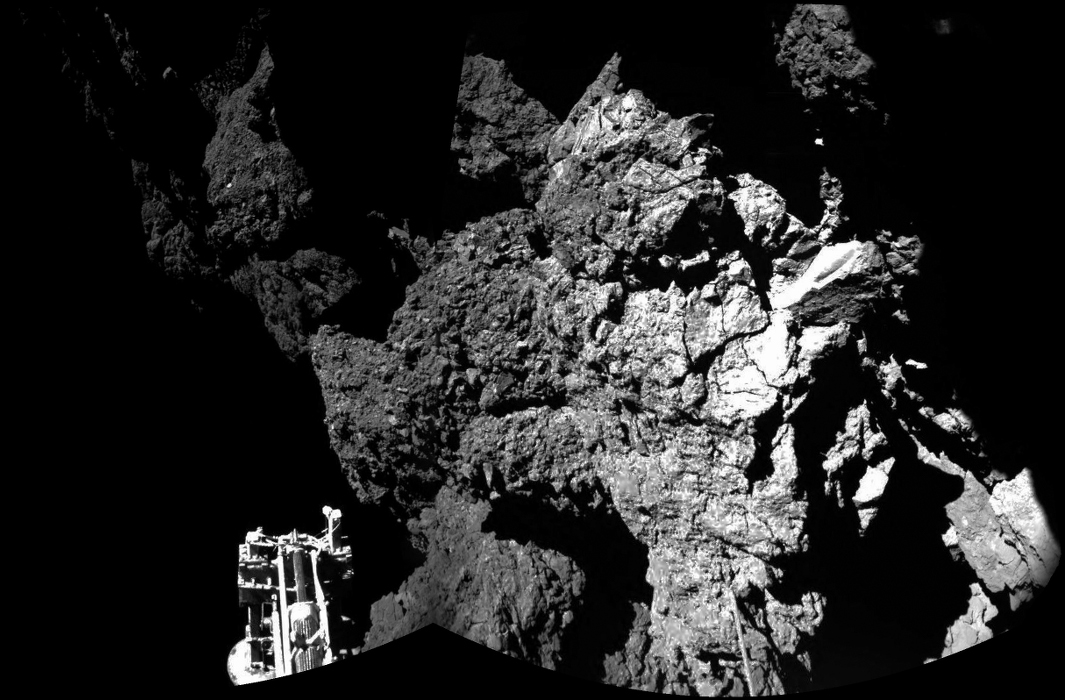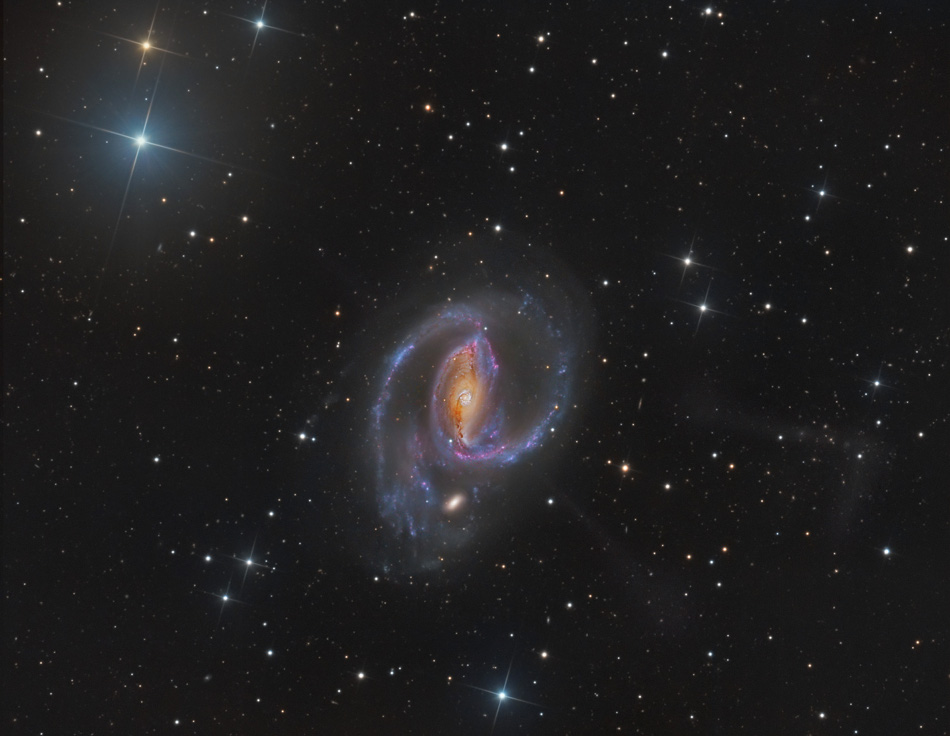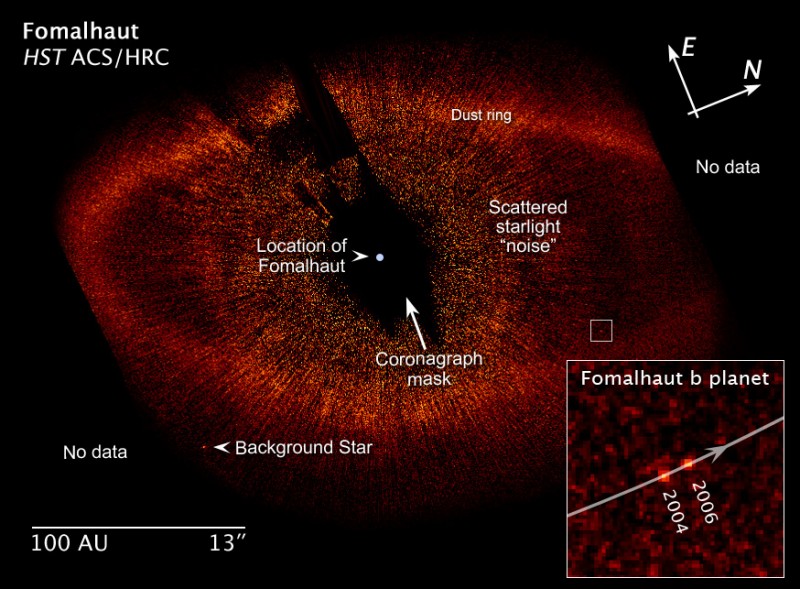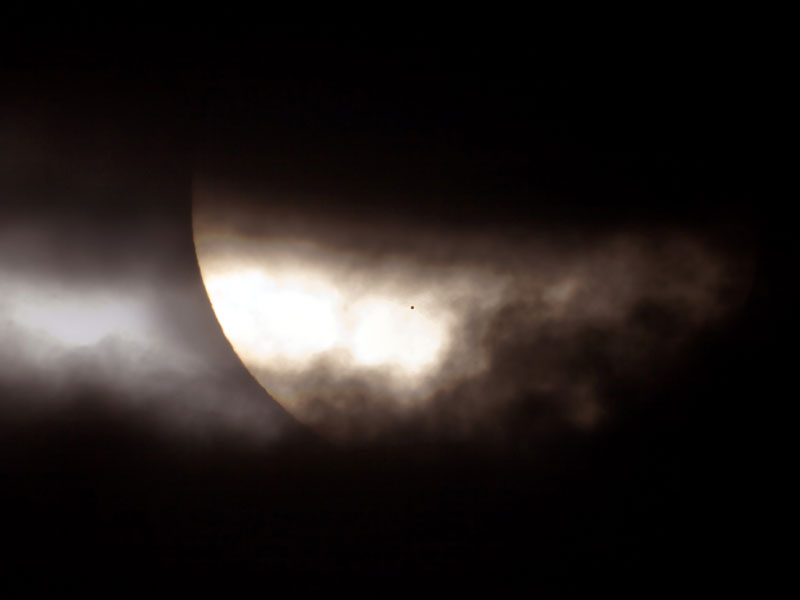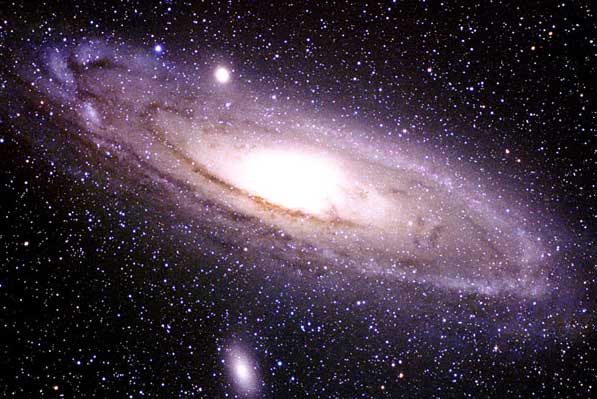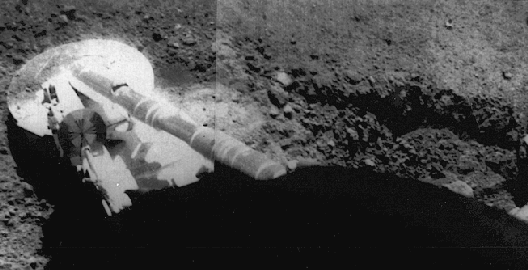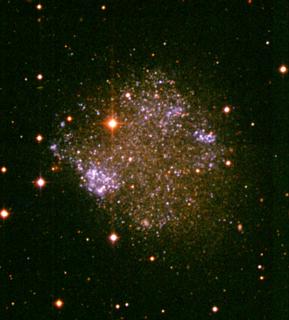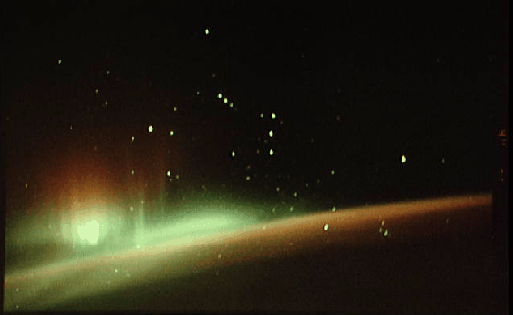| << Previous | Index | Next >> |
2014 The Rosetta Mission lander is safely on a comet. One of Philae's feet appears at the bottom left of this spectacular image of the surface of C67/P Churyumov-Gerasimenko. Still a happy lander, Philae bounced twice before settling and returning images from the surface, traveling a kilometer or so after initially touching at the targeted site Agilkia. A surface panorama suggests that the lander has come to rest tilted and near a shadowing wall, with its solar panels getting less illumination that hoped. Philae's science instruments are working as planned and data is being relayed during communications windows, when the Rosetta spacecraft is above the lander's new horizon.
2013 Enigmatic spiral galaxy NGC 1097 shines in southern skies, about 45 million light-years away in the chemical constellation Fornax. Its blue spiral arms are mottled with pinkish star forming regions in this colorful galaxy portrait. They seem to have wrapped around a small companion galaxy below and left of center, about 40,000 light-years from the spiral's luminous core. That's not NGC 1097's most peculiar feature, though. The very deep exposure hints of faint, mysterious jets, most easily seen to extend well beyond the bluish arms toward the lower right. In fact, four faint jets are ultimately recognized in optical images of NGC 1097. The jets trace an X centered on the galaxy's nucleus, but probably don't originate there. Instead, they could be fossil star streams, trails left over from the capture and disruption of a much smaller galaxy in the large spiral's ancient past. A Seyfert galaxy, NGC 1097's nucleus also harbors a supermassive black hole.
2012
Click to play embedded YouTube video.
Video Credit & Copyright: MelodySheep, Symphony of Science, John Boswell; Music Credit: Our Story
2011 The longer you look at this image, the more you see. Perhaps your eye is first drawn to the picturesque waterfall called Skogarfoss visible on the image right. Just as prevalent, however, in this Icelandic visual extravaganza, is the colorful arc of light on the left. This chromatic bow is not a rainbow, since the water drops did not originate in rainfall nor are they reflecting light from the Sun. Rather, the drops have drifted off from the waterfall and are now illuminated by the nearly full Moon. High above are the faint green streaks of aurora. The scene, captured one night last month, also shows a beautiful starscape far in the background, including the Big Dipper, part of the constellation of the Great Bear (Ursa Major).
2010 Do nearly exact copies of you exist in other universes? If one or more of the multiverse hypotheses is correct, then quite possibly they do. In the above computer-enhanced illustration, independent universes are shown as independent circles or spheres. Spheres may be causally disconnected from all other spheres, meaning no communications can pass between them. Some spheres may contain different realizations of our universe, while others may have different physical laws. An entire set of parallel universes is called a multiverse. The human eye might represent the possibility that realizations of some multiverse hypotheses might only exist in the human mind. One criticism of multiverse hypotheses is that they are frequently difficult to test. Some multiverse hypotheses may therefore be great fun to think about but not practically falsifiable and therefore have no predictive scientific value.
2009 What's 93 million miles away and still hurts your eyes when you look at it? The answer is not the Denver International Airport, known to some travelers as DIA. But DIA does appear in dramatic silhouette in the foreground of this telephoto image. The view looks east toward the airport terminal's characteristic multi-peaked roof and the rising October Sun. The roof's appearance suggests the snow-capped peaks of the region's Rocky Mountains to the west. As winter approaches for denizens of Denver and the northern hemisphere in general, the rising Sun will continue to move south (image right) in the coming days. Of course, the Sun is 93 million miles away ...
2008
2007 Yes, but can your meteor do this? The most powerful natural explosion in recent Earth history occurred on 1908 June 30 when a meteor exploded above the Tunguska River in Siberia, Russia. Detonating with an estimated power 1,000 times greater than the atomic bomb dropped over Hiroshima, the Tunguska event leveled trees over 40 kilometers away and shook the ground in a tremendous earthquake. Eyewitness reports are astounding. The above picture was taken by a Russian expedition to the Tunguska site almost 20 years after the event, finding trees littering the ground like toothpicks. Estimates of the meteor's size range from 60 meters to over 1000 meters in diameter. Recent evidence suggests that nearby Lake Cheko may even have been created by the impact. Although a meteor the size of the Tunguska can level a city, metropolitan areas take up such a small fraction of the Earth's surface that a direct impact on one is relatively unlikely. More likely is an impact in the water near a city that creates a dangerous tsunami. One focus of modern astronomy is to find Solar System objects capable of creating such devastation well before they impact the Earth.
2006 What's that dot on the Sun? If you look closely, it is almost perfectly round. The dot is the result of an unusual type of solar eclipse that occurred last week. Usually it is the Earth's Moon that eclipses the Sun. Last week, for the first time in over three years, the planet Mercury took a turn. Like the approach to New Moon before a solar eclipse, the phase of Mercury became a continually thinner crescent as the planet progressed toward an alignment with the Sun. Eventually the phase of Mercury dropped to zero and the dark spot of Mercury crossed our parent star. The situation could technically be labeled a Mercurian annular eclipse with an extraordinarily large ring of fire. From above the cratered planes of the night side of Mercury, the Earth appeared in its fullest phase. Hours later, as Mercury continued in its orbit, a slight crescent phase appeared again. The next Mercurian solar eclipse will occur in 2016.
2005 If you could stand on Mars -- what might you see? Scroll right to find out. The robotic Spirit rover currently rolling across Mars climbed to the top of hill and took a series of images that were digitally combined into a 360 degree panorama over three days early last month. Spirit was instructed to take images having the same resolution as a human with 20-20 eyesight. The full panoramic result can be found by clicking on the above image and has a level of detail unparalleled in the history of Martian surface photography. The panorama was taken from the pinnacle of Husband Hill and has been dubbed the Everest panorama, in honor of the view from the tallest mountain on Earth. Visible in Gusev Crater are rocks, rusting sand, a Martian sundial, vast plains, nearby peaks, faraway peaks, and sand drifts. In the distance, fast moving dust devils can be seen as slight apparitions of red, green, or blue, the colors of filters used to build up this natural color vista.
2004 The 1999 Leonids Meteor Shower came to an impressive crescendo. Observers in Europe observed a sharp peak in the number of meteors visible around 0210 UTC during the early morning hours of November 18. Meteor counts then exceeded 1000 per hour - the minimum needed to define a true meteor storm. At other times and from other locations around the world, observers typically reported respectable rates of between 30 and 100 meteors per hour. The above photograph is a 20-minute exposure ending just before the main Leonids peak began. Visible are at least five Leonids meteors streaking high above the Torre de la Guaita, an observation tower used during the 12th century in Girona, Spain. This year's Leonids should peak twice on November 19th, but is predicted to be less impressive than in 1999.
2003 Every day is a cloudy day on Jupiter, the Solar System's reigning gas giant. And swirling cloud tops are all you see in this stunningly detailed true color image, a portion of a large digital mosaic portrait of Jupiter recorded from the Cassini spacecraft during its Jovian flyby in December 2000. The smallest features visible are about 60 kilometers across. Jupiter's composition is dominated by hydrogen and the clouds contain hydrogen compounds like ammonia, hydrogen sulfide, and even water. A truly giant planet, Jupiter's diameter is over 11 times the diameter of Earth and the smallest storms visible in the Cassini Jupiter portrait are similar in size to large terrestrial hurricanes. Now traveling beyond Jupiter, the Cassini spacecraft is scheduled to reach the Saturnian system in July of 2004.
2002 This stunning image shows remarkable and mysterious details near the dark central region of a planet-sized sunspot in one of the sharpest views ever of the surface of the Sun. Just released, the picture was made using the Swedish Solar Telescope now in its first year of operation on the Canary Island of La Palma. Along with features described as hairs and canals are dark cores visible within the bright filaments that extend into the sunspot, representing previously unknown and unexplored solar phenomena. The filaments' newly revealed dark cores are seen to be thousands of kilometers long but only about 100 kilometers wide. Resolving features 100 kilometers wide or less is a milestone in solar astronomy and has been achieved here using sophisticated adaptive optics, digital image stacking, and processing techniques to counter the blurring effect of Earth's atmosphere. At optical wavelengths, these images are sharper than even current space-based solar observatories can produce. Recorded on 15 July 2002, the sunspot shown is the largest of the group of sunspots cataloged as solar active region AR 10030.
2001 Auroras in the north and south can be nearly mirror images of each other. Such mirroring had been suspected for centuries but dramatically confirmed only last month by detailed images from NASA's orbiting Polar spacecraft. Pictured above, a time-lapse movie shows simultaneous changes in aurora borealis, at the top, and aurora australis, at the bottom. A cloud of electrons and ions moving out from the Sun on October 22 created the auroras. The solar explosion that released the particles occurred about three days earlier.
2000 OK, fans of classic science fiction might be disappointed. The yardangs are not barsoomian warriors in a newly discovered Edgar Rice Burroughs tale of adventure and conquest on the Red Planet. In fact yardangs, geologists' term for narrow, wind-eroded ridges, are common land features in the desert regions of planet Earth. Such Eolian (wind related) landforms are common on Mars too, and this recently released Mars Global Surveyor picture shows long, sculpted yardangs in the eastern Aeolis region of southern Elysium Planitia. These martian yardangs may have formed in deposits of volcanic ash. Covering a swath of the martian surface 2.5 kilometers high, this composite image does offer special effects, though. If you have red/blue glasses (red for the left eye) you can view the yardangs of Mars in astounding 3-D!
1999 Andromeda is the nearest major galaxy to our own Milky Way Galaxy. Our Galaxy is thought to look much like Andromeda. Together these two galaxies dominate the Local Group of galaxies. The diffuse light from Andromeda is caused by the hundreds of billions of stars that compose it. The several distinct stars that surround Andromeda's image are actually stars in our Galaxy that are well in front of the background object. Andromeda is frequently referred to as M31 since it is the 31st object on Messier's list of diffuse sky objects. M31 is so distant it takes about two million years for light to reach us from there. Much about M31 remains unknown, including why the center contains two nuclei.
1998 "Safe!" In September 1967 (during regular season play), the Surveyor 5 lander actually slid several feet while making a successful soft landing on the Moon's Mare Tranquillitatis. Equipped with television cameras and soil sampling experiments, the US Surveyor spacecraft were intended to determine if the lunar surface at chosen locations was safe for manned landings. Surveyor 5 touched down on the inside edge of a small crater inclined at about 20 degrees. Its footpad slipped and dug the trench visible in the picture. Covered with dusty lunar soil, the footpad is about 20 inches in diameter.
1997 Grand spiral galaxies often seem to get all the glory. Their newly formed, bright, blue star clusters found along beautiful, symmetric spiral arms are guaranteed to attract attention. But small irregular galaxies form stars too, like this lovely, gumdrop-shaped galaxy, Sextans A. A member of the local group of galaxies which includes the massive spirals Andromeda and our own Milky Way, Sextans A is about 10 million light years distant. The bright Milky Way foreground stars appear yellowish in this view. Beyond them lie the stars of Sextans A with tantalizing young blue clusters clearly visible.
1996 massive star ends life as a supernova, blasting its outer layers back to interstellar space. The spectacular death explosion is initiated by the collapse of what has become an impossibly dense stellar core. However, this core is not necessarily destroyed. Instead, it may be transformed into an exotic object with the density of an atomic nucleus but more total mass than the sun - a neutron star. Directly viewing a neutron star is difficult because it is small (roughly 10 miles in diameter) and therefore dim, but newly formed in this violent crucible it is intensely hot, glowing in X-rays. Images from the ROSAT X-ray observatory above may offer a premier view of such a recently formed neutron stars' X-ray glow. Pictured is the supernova remnant Puppis A, one of the brightest sources in the X-ray sky, with shocked gas clouds still expanding and radiating X-rays. In the inset close-up view, a faint pinpoint source of X-rays is visible which is most likely the young neutron star, kicked out by the asymmetric explosion and moving away from the site of the original supernova at about 600 miles per second.
1995 Looking toward the south from low Earth orbit, the crew of the Space Shuttle Endeavor made this stunning time exposure of the Aurora Australis (southern lights) in April of 1994. The aurora are caused by high energy electrons from the Solar Wind which are funneled into the atmosphere by the Earth's magnetic field. The reddish colors occur at the highest altitudes (about 200 miles) where the air is least dense. At lower altitudes and greater densities green tends to dominate. At the lowest altitudes a pinkish glow is sometimes produced. The familiar constellation of Orion the Hunter is clearly visible above the dark horizon in the background. Because of the shuttle's orbital motion, the bright stars in Orion appear slightly elongated.
| << Previous | Index | Next >> |
